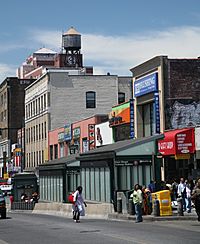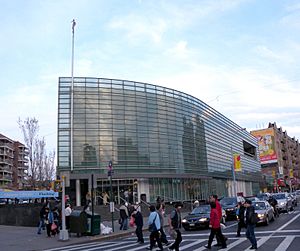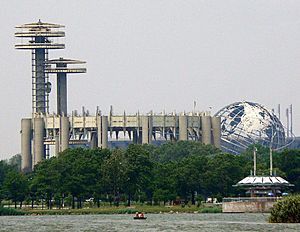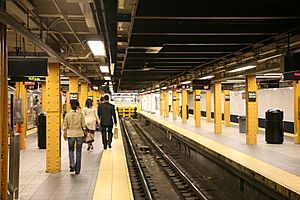Koreatown, Queens facts for kids
Quick facts for kids
Koreatown, Queens
|
|
|---|---|
|
Neighborhoods of Queens
|
|

Roosevelt Avenue in Flushing, Queens
|
|
| Country | |
| State | |
| Counties | |
| Agglomeration | New York metropolitan area |
Koreatown, Queens (Korean: 롱 아일랜드 코리아타운) is a vibrant neighborhood in New York City. It's one of the biggest and fastest-growing Korean communities outside of Korea. This area is mostly found along Northern Boulevard in the Queens borough.
Contents
Where is Koreatown, Queens?
This special neighborhood first started in Flushing, Queens. It has grown a lot towards the east. The community now stretches along Northern Boulevard. It includes parts of Murray Hill, Auburndale, Bayside, and Douglaston, Little Neck.
History of Koreatown
How Flushing's Koreatown Started
In the 1980s, many Korean immigrants came to Flushing. Some worked in healthcare, and others were students. They came to New York City for jobs or to start businesses. They set up shops on Union Street in Flushing. This area soon became a lively Koreatown.
You could find many things there. There were Korean restaurants and karaoke bars. There were also nail salons, grocery stores, and bookstores. You could also find banks, offices, and clothing shops. This is how Koreatown in Flushing began.
Koreatown's Look and Feel
As you walk through Koreatown, you'll see many signs in Hangul. This is the Korean alphabet. It shows how much Korean culture is part of the neighborhood.
Growing Eastward
As the Korean community grew, people moved to bigger homes. They moved to quieter neighborhoods in Queens. By the early 2000s, they also moved into nearby Nassau County. This growth created a "Restaurant Street" in Murray Hill, Queens. It's called Meokjagolmok in Korean. This area feels just like Seoul, the capital of Korea.
The community couldn't easily expand west. That's because the large Flushing Chinatown was in the way. So, they kept moving east instead.
People and Population
In 2010, over 64,000 Korean people lived in Queens. This makes it one of the largest Korean communities in the U.S. The Korean population in Nassau County also grew a lot. It nearly doubled to about 14,000 people.
Koreatown in Queens is a big part of the Korean American community in the New York City Metropolitan Area. There are over 218,000 Koreans living in this wider area. This is the second-largest group of Koreans outside of Korea. You can even fly directly from Seoul to JFK Airport in Queens.
Weather in Koreatown
Koreatown has a humid subtropical climate. This is similar to Seoul, South Korea. It gets a good amount of sunshine each year.
Schools and Public Places

Queens Library in Flushing.

Koreatown residents can enjoy an urban oasis at Flushing Meadows-Corona Park.
|
People in Koreatown can enjoy Flushing Meadows-Corona Park. It's a large park where you can relax and play. There are also many Queens Library branches nearby. These libraries offer books and resources for everyone. The area has many public and private schools. Some are very popular, like those in the Great Neck School District.
Getting Around Koreatown

The New York City Subway's (7 <7> trains) train ends at the Flushing – Main Street station. This is one of the busiest subway stations in the city. The intersection of Main Street and Roosevelt Avenue is very busy too. It's one of the busiest spots in New York City.
Many buses also stop at Main Street and Roosevelt Avenue. The Port Washington Branch of the Long Island Rail Road also serves the area. You can also drive to Koreatown using major highways. These include the Grand Central Parkway and the Whitestone Expressway.
News and Media
The Korea Times, a newspaper from Seoul, is very popular here. You can also find major New York City newspapers. These include The New York Times and Newsday.
International News
In 2014, an event involving Korean Air happened at John F. Kennedy International Airport in Queens. This event made news around the world.
Food in Koreatown
Koreatown is famous for its amazing Korean food. Some say Queens has the most authentic Korean food outside of Korea. You can find many restaurants serving traditional Korean dishes. As mentioned before, the "Restaurant Street" in Murray Hill feels just like Seoul. You can also find Korean Chinese cuisine here.
Languages Spoken
Both Korean and English are spoken a lot in Koreatown. You'll see many signs written in the Hangul alphabet.
Community Support
There are many helpful services in Koreatown. These services help new and established Korean immigrants. They offer support for people settling into the community.


